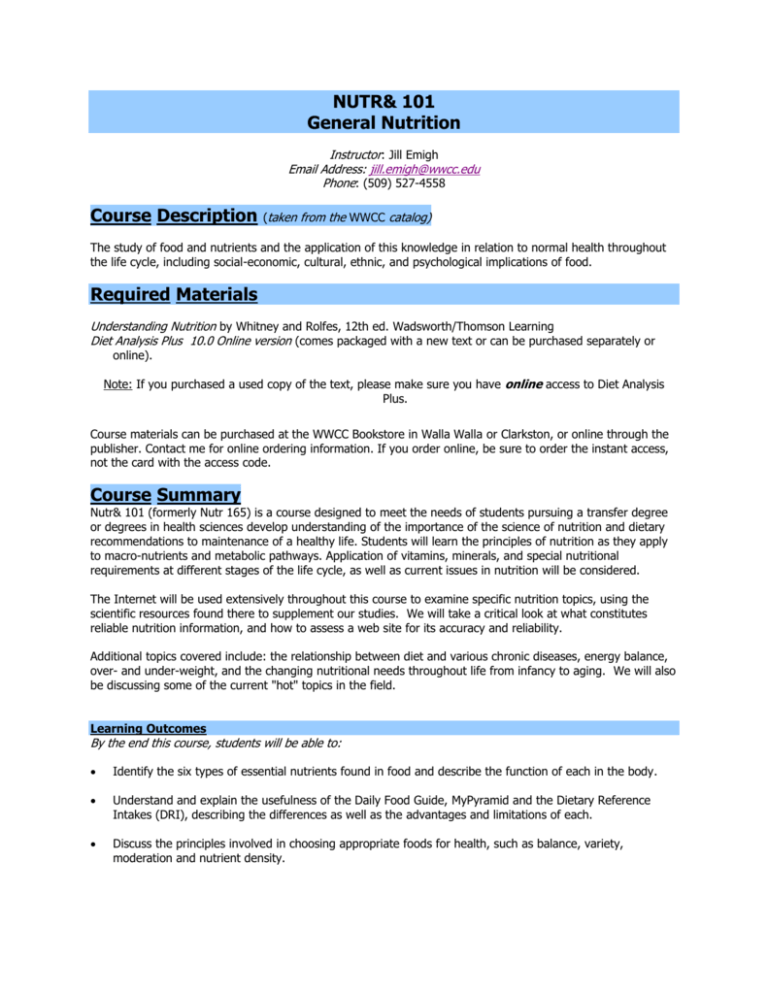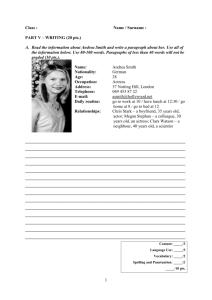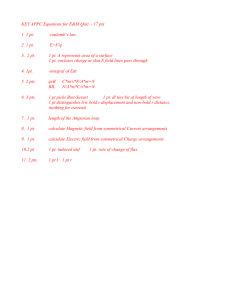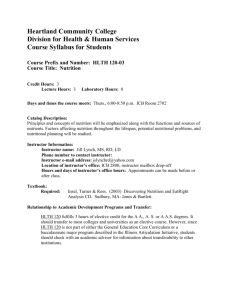View Syllabus - Walla Walla Community College
advertisement

NUTR& 101 General Nutrition Instructor: Jill Emigh Email Address: jill.emigh@wwcc.edu Phone: (509) 527-4558 Course Description (taken from the WWCC catalog) The study of food and nutrients and the application of this knowledge in relation to normal health throughout the life cycle, including social-economic, cultural, ethnic, and psychological implications of food. Required Materials Understanding Nutrition by Whitney and Rolfes, 12th ed. Wadsworth/Thomson Learning Diet Analysis Plus 10.0 Online version (comes packaged with a new text or can be purchased separately or online). Note: If you purchased a used copy of the text, please make sure you have online access to Diet Analysis Plus. Course materials can be purchased at the WWCC Bookstore in Walla Walla or Clarkston, or online through the publisher. Contact me for online ordering information. If you order online, be sure to order the instant access, not the card with the access code. Course Summary Nutr& 101 (formerly Nutr 165) is a course designed to meet the needs of students pursuing a transfer degree or degrees in health sciences develop understanding of the importance of the science of nutrition and dietary recommendations to maintenance of a healthy life. Students will learn the principles of nutrition as they apply to macro-nutrients and metabolic pathways. Application of vitamins, minerals, and special nutritional requirements at different stages of the life cycle, as well as current issues in nutrition will be considered. The Internet will be used extensively throughout this course to examine specific nutrition topics, using the scientific resources found there to supplement our studies. We will take a critical look at what constitutes reliable nutrition information, and how to assess a web site for its accuracy and reliability. Additional topics covered include: the relationship between diet and various chronic diseases, energy balance, over- and under-weight, and the changing nutritional needs throughout life from infancy to aging. We will also be discussing some of the current "hot" topics in the field. Learning Outcomes By the end this course, students will be able to: Identify the six types of essential nutrients found in food and describe the function of each in the body. Understand and explain the usefulness of the Daily Food Guide, MyPyramid and the Dietary Reference Intakes (DRI), describing the differences as well as the advantages and limitations of each. Discuss the principles involved in choosing appropriate foods for health, such as balance, variety, moderation and nutrient density. Discuss the digestion, absorption, metabolism and chemical structure of the dietary carbohydrates, proteins and fats/lipids. Identify good food sources of each. Describe the roles of vitamins and minerals in the body. For each of the major water- and fat-soluble vitamins and the major and trace minerals, list the bodily functions, several good food sources, and deficiency and toxicity symptoms for selected nutrients. Analyze food intake records for nutritional adequacy using the tools listed in above. Discuss how specific changes to these records can result in diets of improved content and quality. List ten sources of scientifically accurate nutrition information found on the Internet. Be able to differentiate between accurate, reliable and inaccurate, unreliable nutrition information. Understand and discuss the relationship between healthy food choices, weight loss and physical activity. Be able to design an effective weight control program. Explain how nutritional requirements change at different stages of life including pregnancy, lactation, infancy, childhood, adolescence and adulthood. Discuss the relationship between diet and various chronic diseases, including the role of functional foods. Course Format This is an online course taught through WAOL using the angel platform. In keeping with the ‘anywhere, anytime’ philosophy of distance learning, all requirements of the course will be completed online within the flexibility of each individual’s schedule. This course is not self-paced. It is organized into ten Weekly Lessons, and students will be responsible for completing all activities for the week by the due date assigned during that week. Each week is organized in a similar fashion, and includes the following: Learning Outcomes: Read through this list of goals for the week atleast twice, once at the beginning of the lesson and once again at the end of it. This should help focus your studying, and serve as a way to check that you have gained mastery over the most important material. Reading Assignment: Your first resource for reliable information is our textbook. It is critical that you read the assigned pages. Lecture: There will be PowerPoint presentations with audio files imbedded that are based on the required reading in the text and some supplementary information. These are best viewed using the slide presentation feature in PowerPoint Diet Analysis Plus (DAP) Assignment: One assignment per week will be given for the first seven weeks of the course. Week eight will complete our use of the DAP program Web and/or Media Investigations: Web sites and/or journal articles containing current nutrition information will be investigated. Emphasis willbe placed on determining validity and reliability of the resource, as well as the quality of the information presented. Study Guide Questions/Short Answer: Lists of study questions based on the reading assignments and lectures will be provided for you to answer. These are not handed in and are not graded. They are provided to focus your study. Discussion Activity: Each lesson requires participation electronically in our classroom Discussion Forum. You will be asked to post your opinion, insights or answers to questions each week, as well as to respond to other students’ postings. The goal of this activity is to simulate classroom discussion. It is imperative that you plan your study time for the week well, and pace yourself listening to the lectures and studying the text. If you wait until the end of the week to do it all, you will fall behind very quickly. NOTE: I will grade each of your assignment within 72 hours of the due date. Assignments posted late may take longer. Participation Policy One of the most difficult aspects of distance learning is managing your time and disciplining yourself to keep up with lectures, readings and assignments without the benefit of daily contact with the instructor and other students. You should expect to spend at least fifteen hours per week studying the material and completing the weekly assignments. I recommend logging in to the classroom at least five days out of seven, and checking your email daily for any communication either from myself or other students. Please make use of the Discussion Forum to post any questions you have which are related to the course content. I encourage students to help each other out with answering these, but I will also be involved and answer questions regularly. I check the classroom activity frequently, usually 3 times daily, the same for my email. You have the right to expect a timely response from me concerning issues you have in the course. One of the big problems students experience in an online classroom is procrastination with studying and completing assignments, which can really create a problem if you experience trouble with your computer or need help understanding the material at the last minute. I will do my best to provide a variety of learning experiences in the classroom, however I cannot anticipate the needs and questions of each and every student, so you will need to take a proactive approach and ask when you do not understand something or when you need assistance. After you post an assignment is too late...ask for clarification before the due date! Technical Support If you are having difficulty with any technical issues, again, I will do my best to assist you—I am committed to each student having a successful learning experience. (Remember that I am not online 24/7, though, and I often take Sundays off.) WAOL has assistance available, and the help desk at Presidium is open 24/7 by calling 1-866-425-8412 (toll free) or accessing http://supportcenteronline.com/ics/support/default.asp?deptid=863. They will respond to your technical questions or problems in a timely manner. Testing 3 exams will be given during the quarter, each covering approximately 2 - 3 week's worth of material (50 questions each worth two points). There will also be a 100 question final exam. Half will cover the last weeks and the other half is cumulative. The exams will be open and available for you to take from Thursday at 12:01 am through Monday at midnight as your schedule permits. There will be a time limit for each exam. The final will be available for three days only at the end of the quarter. Once you open the exam you must complete it. You will not be able to open it again. You must use a high speed Internet connection for any exam you take in this course. Do not use a wireless connection because if it fails, you will be unable to reenter the exam. All exams (including the final) may consist of essay, short answer, multiple choice, matching and/or true or false questions. More details on these will be given as we get closer to the actual testing dates. Please note that I reserve the right to change this syllabus as we move through the course, depending on circumstances that arise. I will notify you on the Announcements page if this occurs. Introductory Assignment 10 Discussion Board Assignments @ 20 pts each 7 DAP Assignments @15 pts each Attempt at Perfection 3 exams @ 100 pts each Final Total = 15 pts = 200 pts = 105 pts = 200 pts = 300 pts = 200 pts 1020 pts








